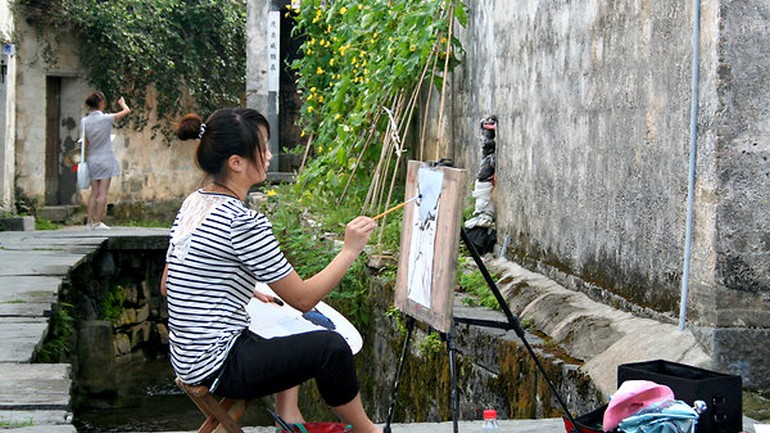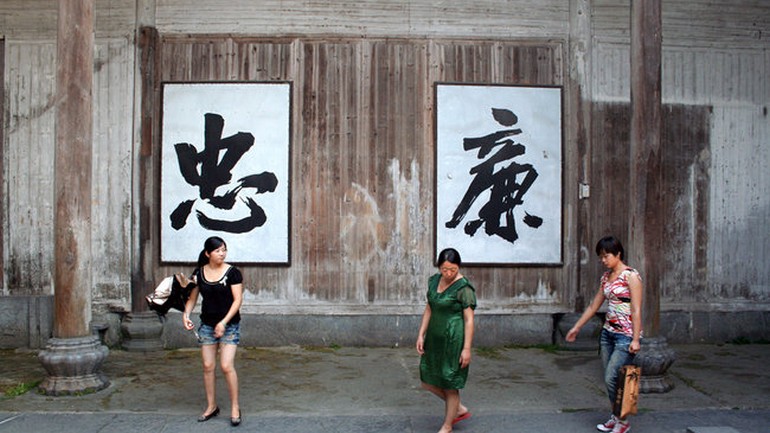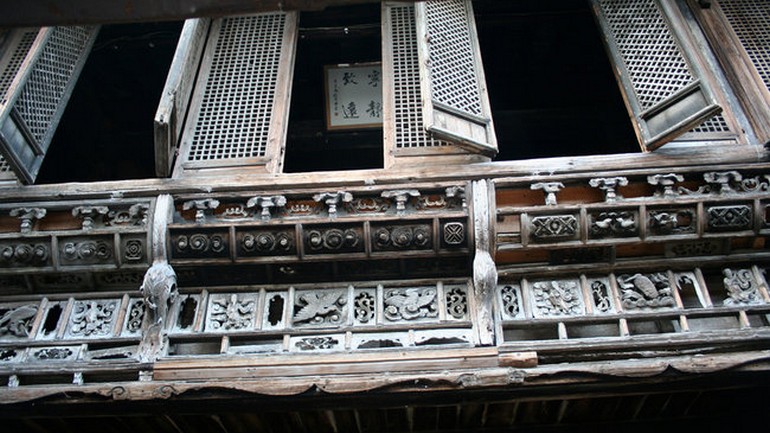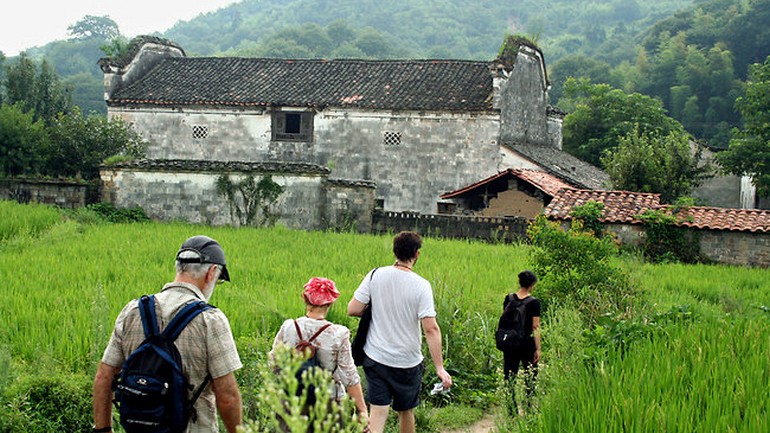Just 250 or so miles to the west of the gleaming high-rises of Shanghai sits a window into a world hundreds of years old. Despite the dramatic upheavals brought by war, the Cultural Revolution and industrialization, the hamlet of Xidi, in the mountainous province of Anhui, along with other villages in the area, has managed to remain largely untouched since the late Ming and early Qing dynasties, starting hundreds of years ago. Wander the narrow, labyrinthine lanes and peek into the open-air courtyards of grandiose homes, with their wooden lattice windows, rock gardens, watercolors and calligraphy scrolls, and it can feel as if you are slipping back in time to the days of the Chinese emperors.
从鳞次栉比的现代上海向西行250英里,就会打开通往几百年前古老世界的一扇窗。战争、文革、以及工业化带来的剧变,几乎没有渗入皖南山区;小镇西递,与这一地区的其他村落,依然保持着几百年前的明清风韵。漫步在狭窄而错综复杂的小路上,窥视大宅的院落,那一扇扇木格窗、一个个小小的园林、一幅幅墨迹,仿佛让时光倒流,令你置身于古老的帝国。
As more and more Chinese move to cities, the small villages of Anhui offer a respite. And perhaps even more surprising, young artists and entrepreneurs are embracing these spots with a renewed sense of pride in their modest scale and tangible sense of history.
当越来越多中国人涌向城市,这些位于安徽的小村落提供了一个得以小憩的地方。或许更让人惊奇的是,年轻的画家和企业家给这里适中的规模和踏实的历史带来了一股新的自信活力。

After the sun begins sinking behind the whitewashed walls of Xidi’s houses and the day-trippers board their buses home, the art students, visiting from the large provincial capital of Hefei and other nearby cities, linger overnight or for the weekend. Perched behind easels in the granite-tile lanes or on rocks in the shallow streams flowing through the village, they appear inspired by the classical architecture, which has all but disappeared in their skyscraper-studded cities. “Young people don’t typically like this; they prefer big-city culture,” said Wang Nanyan, an 18-year-old from Hefei. “But I’m different. I’m an artist — I like these kinds of buildings.”
当太阳被掩藏于西递村舍的白墙之后,一日游的游客们踏上返程的旅途,而从省会城市合肥和其他临近城市来的美术学生,还会在此过夜,甚至逗留整个周末。他们将画板立在青石小路或是绕村流过的小溪中的岩石上,在画板后静静作画。这些学生看起来在传统建筑中找到了灵感,而这些传统建筑在大厦林立的城市里已经无影无踪。“年轻人往往并不喜欢这里;他们更倾心大城市文化,”一位来自合肥的18岁学生王楠燕说道,“但我不同。我是画家——我喜欢这样的建筑。”
Xidi, in particular, has an illustrious history. Founded in 1047 by the Hu family, Xidi began to grow rich as a trading center during the Ming dynasty (1368-1644). As the population swelled, the Hus gained power as imperial officials and built elaborate two-story compounds and giant archways, one of which still stands at the entrance to the town. The fortunes of the town began to decline came after the end of the Qing dynasty (1644-1911), but signs of Xidi’s former glory still abound.
西递尤其具有久远的历史。它是在公元1047年由胡家建立的,而在明朝(公元1368-1644年)时作为一个商贸中心,开始积累财富。当人丁兴旺后,胡氏家族通过皇家敕封的官职获得权力,并在村中建造双层住宅及雄伟的拱门,其中之一仍然伫立在村庄入口处。西递的财富在清朝(公元1644-1911年)末期之后开始衰退,但村庄依然充满着代表从前辉煌的标志。

The size of many of the former merchant homes still impresses. The most majestic were built in the 1600s and designed in the traditional Huizhou style. Interior courtyards, filled with gardens and small fishponds, open on to formal meeting halls where portraits of ancestors hang from the highest points on the walls. Nearly every surface, whether wood or stone, is elaborated carved — the door frames, the braces supporting the ceiling beams, the second-story balconies. But perhaps the most distinctive features are the “horse-head walls” that bookend the rooftops, so called because the upturned edges of the multitiered walls resemble horses’ heads.
从前商贾之家留下的许多房屋,现在看来依然宏大。最大的一户建于17世纪,是传统的徽派建筑。这里的庭院中到处是花园和小鱼池,会议厅面朝天井,厅内从高处往下,悬挂着这家祖先的肖像。建筑中几乎所有的裸露部分,不管是木质还是石质,都有着精细的雕刻——门框,支撑横梁的梁架、楹柱,二楼的阳台。但徽派建筑中最与众不同的是“马头墙”,即高于两山墙屋面的墙垣,因形似马头而得名。
Li Guoyu, an artist from Shanghai, was drawn to this graceful architecture when she started looking for a property to turn into an inn in the early 2000s. The one she settled on wasn’t nearly as grand as others in Xidi — it was a teacher’s home during the Ming dynasty and was being used as a pigsty when she found it. But Mrs. Li saw potential in the 400-year-old property. “Many people dream of finding a paradise, but they never really find such a place,” she said. “But I did.”
李国玉,一位来自上海的画家,在21世纪初期想找寻一宗产业并将其改造为旅社,而她被这种优雅的建筑所吸引。在西递,她开设的这家旅社不如别家规模大——这间房屋是明朝的一个塾师住宅,而且在她找到之前是作为猪舍使用。但李女士看到了这座四百年历史的房屋的潜在价值。“许多人梦想着找寻天堂,但他们从没有真正找到这样的地方,”她说,“但我找到了。”

Most tourists focus solely on Xidi and Hongcun because of their Unesco status and proximity to each other, but there are other hamlets in the Anhui mountains that have equally exquisite architecture and, more important, a fraction of the visitors. One is Zhaji, a two-hour drive north of Xidi. The tiny village is also made up of whitewashed homes with black-tile roofs clinging to the banks of a muddy stream, but the houses here are far simpler, belonging mostly to farmers. There are few shops and restaurants and no art students. Locals dry peanuts on giant bamboo baskets in the sun and make their own tofu. Xidi feels like Shanghai in comparison.
绝大多数游客仅仅会去西递和宏村,因为它们在世界遗产名录中,而且相互毗邻,但安徽山区的其他小村落同样拥有精致的建筑,更为重要的是,那里的游客少很多。其中之一是查济,在西递以北车程两小时处。这个小村庄临着一条泥泞的溪流,同样有着白墙黑瓦的宅子,但这些宅子非常朴素,大多数属于当地农户。这里几乎没有商店、饭馆以及美术学生。当地人将花生装在巨大的竹编篮子里,在日光下晒干,而且自己磨豆腐。相比之下,西递如同上海。
This rural idyll is exactly what Julien Minet was looking for when he became a homeowner in the area in the early 2000s. Mr. Minet, a Frenchman, had traveled around Anhui for years writing an ethnographic study on ancient villages for Unesco, and he took such a liking to Zhaji, he bought an abandoned Ming dynasty-era house in 2003 for the shockingly low price of 10,000 renminbi. Needless to say, it was a fixer-upper. “The house had chickens living inside,” he said. “But then I saw all the mountains outside. The panorama is just wonderful.”
这样的田园牧歌式生活正是Julien Minet于21世纪初在这一地区购买房屋时想要找寻的。Minet先生,来自法国,多年来在安徽各地旅行,并为联合国教科文组织撰写关于古村落的民族志研究。他是如此的喜欢查济,以至于2003年在此购买了一座废弃的明朝住宅,人民币10000元的价格低得令人乍舌。不用说,这座房子在使用前必须进行大量修缮。“屋子里原来还有鸡,”他说道,“但之后我看到了外面的群山。景色太棒了!”

After an arduous three-year renovation — which included finding antiques from the area and the addition of a small pool ensconced in bamboo, essential for the region’s scorching summers — he opened his three-bedroom guesthouse, Chawu, in 2006. Catering mostly to French tourists, including the occasional V.I.P. (a French education minister once stayed there), Mr. Minet aims to offer a traditional Anhui experience to his guests, with a personal tour of the village and “country food” cooked by one of his neighbors. His only concessions to the 21st century and his native France: free Wi-Fi and the pastis he serves beneath the chestnut tree in his garden at sundown.
经过三年的辛勤翻新——包括寻找当地的古董,为了酷暑在竹林里开辟的水池——他有着三间卧室的旅社,茶师屋,在2006年开业了。旅社主要面向法国游客,包括偶尔的VIP(一位法国教育部长曾下榻于此),Minet先生旨在向他的客人们提供一个传统的安徽经历,如在村中的个人游,以及由一位邻居烹饪的“乡村食物”。他对21世纪和法国风格的仅有妥协是:免费的Wi-Fi和傍晚在花园里的栗子树下提供法国茴香酒。



 闽公网安备 35020302035673号
闽公网安备 35020302035673号
0 responses on "Ancient charm of Anhui, China"